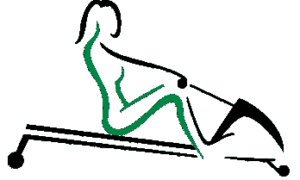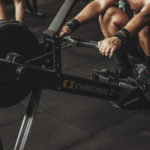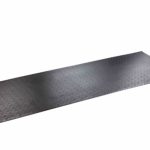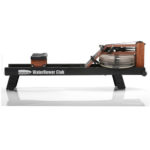Contents
When you buy through links on our website, we may earn a small commission at no cost to you. Thanks for your support 🙂
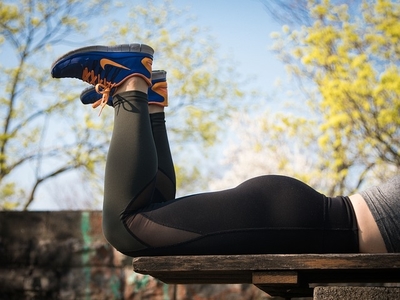 Comfort is essential when it comes to exercising. While rowing, your body has three main contact areas with the boat or rowing machine: your feet, hands, and butt. These points can easily become uncomfortable, sore, or even painful over time.
Comfort is essential when it comes to exercising. While rowing, your body has three main contact areas with the boat or rowing machine: your feet, hands, and butt. These points can easily become uncomfortable, sore, or even painful over time.
Your butt supports your weight and also serves as the main pivot point while you’re rowing. It’s a tough situation because the gluteus maximus (muscles of the butt) have to work while being sat upon during the stroke.
What causes rowing machine butt pain and how can you avoid it?
- Improper form while rowing
Rowing machine butt pain, which is also known as “rower’s bum”, can result from improper form. Weak abdominal muscles cause some rowers to overcompensate in the gluteal muscle and lower back in general, which can lead to butt pain.
Working on your back and core strength to improve muscular fitness can help prevent painful buttocks. Flexibility training can also help you achieve the necessary range of movement and fitness to row effectively.
- Your rowing machine seat design
The seat on the rower should be designed both to allow healthy circulation and support the rower’s weight. A seat that restricts blood circulation can cause rowing machine butt pain. Since most rowing machine models are designed to be one size fits all, this creates a problem for users without an average-sized butt. As a result, some users may find that the rowing seat is not as comfortable as they would like.
- Seat padding
If your tailbone feels uncomfortable and your butt is going numb while rowing, padding could be the underlying cause. If too much padding is causing numbness and cramping, try less padding. However, if you’ve tried less padding and your butt is still taking a beating, try extra padding.
If you need more padding, you can use a piece of bubble wrap or a folded towel. You can also buy rowing shorts or extra rowing seat pads, which provide extra padding.
| PRODUCT PREVIEW | NAME | CUSTOMER RATINGS | CHECK PRICES |
|---|---|---|---|
| Silicone rowing machine seat cover - WaterRower | 2 Customer Ratings | ||
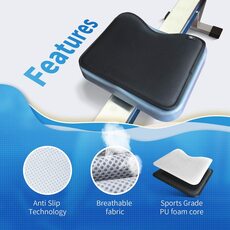 | Rowing machine seat cushion fits Hydrow, Concept2, and others | 2414 Customer Ratings | |
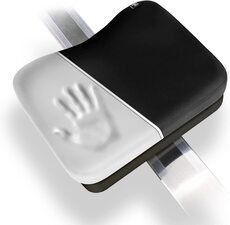 | Hornet Watersports Memory foam cushion for Concept 2 | 420 Customer Ratings | |
- Rower seat size
Even a minor misfit, being too small or too big for the seat, can lead to butt pain. This is largely due to the combination of your weight being supported by your butt while the gluteus maximus works as the main muscle group for fueling the driving motion.
By pivoting backward and forward over your butt, sitting bone, and tailbone while rowing, it is possible to become uncomfortable, sore, or find yourself in pain. The best thing to do when you want to buy a rowing machine is to experiment with different models and choose a seat that fits it’s you comfortably.
- Overuse/overtraining
Any sudden changes in the type of boat rowed, rowing technique, the training level or an abrupt increase in the frequency of training can contribute to the occurrence of butt pain.
- Poor rowing technique

For instance, if your feet are too high in the rowing machine, you tend to push downwards, meaning you tend to come off your seat. Always make sure you sit evenly on your butt cheeks to avoid uneven weight distribution.
Learn more about good rowing techniques here!
- Back injury
Some rowers who undertake intensive rowing regimes tend the experience low back pain. When there’s an injury to the lower back, the pain can radiate to the gluteal muscle and pain typically occurs when sitting and also when the legs are extended at the end of a rowing stroke.
What can you do to make the rowing seat more comfortable?
- Stretch and warm up properly. It may also be helpful to get off the rower and stretch every 30 minutes, especially for longer-duration rows.
Learn and practice proper rowing techniques. Rowing too far back, especially at the finish of the rowing stroke can increase pressure on the tailbone. You can try adjusting your position by sliding an inch or two backward or forward on the seat to alleviate pressure on any one area on your butt.
- Try removing or adding seat pads. If your seat pad is equipped with removable holes, try removing or adding the holes in the seat pad to see which option works best for your butt bones.
- Try different rowing shorts. Shorts vary in style and weight; some rowing shorts have padding, chamois, or double layers for extra comfort.
There are several suggestions for managing rowing machine butt pain such as proper positioning, proper form, and regular stretching.
Best Stretches for Rowing
My go-to rowing stretches
![]() Hip flexor stretch: Kneel on the floor with your right knee bent in front of you and your left leg extended out behind you. While keeping your back straight, lean forward until you feel a stretch in your left hip. Hold for 30 seconds, then change sides.
Hip flexor stretch: Kneel on the floor with your right knee bent in front of you and your left leg extended out behind you. While keeping your back straight, lean forward until you feel a stretch in your left hip. Hold for 30 seconds, then change sides.
![]() Glute stretch: Sit on the floor with your legs extended out in front of you. Bend your right knee and cross your right foot over your left knee. Reach your hands behind your left leg and pull your left knee towards your chest. Hold this stretch for 30 seconds, then switch sides.
Glute stretch: Sit on the floor with your legs extended out in front of you. Bend your right knee and cross your right foot over your left knee. Reach your hands behind your left leg and pull your left knee towards your chest. Hold this stretch for 30 seconds, then switch sides.
![]() Hamstring stretch: Sit on the floor with your legs extended out in front of you. While keeping your back straight, reach out towards your toes, and hold for 30 seconds.
Hamstring stretch: Sit on the floor with your legs extended out in front of you. While keeping your back straight, reach out towards your toes, and hold for 30 seconds.
![]() Pigeon pose: Start on all fours, then slide your right knee forward between your hands. Extend your left leg behind you, keeping your toes pointed. Lower your body down to the ground and rest your forearms on the floor. Hold for 30 seconds, and then change sides. (This is one of my favorites:)
Pigeon pose: Start on all fours, then slide your right knee forward between your hands. Extend your left leg behind you, keeping your toes pointed. Lower your body down to the ground and rest your forearms on the floor. Hold for 30 seconds, and then change sides. (This is one of my favorites:)
However, one of the easiest ways of dealing with rowers’ bum is by simply buying a good and comfortable seat pad or seat cushion.
Check out our Most popular rowers HERE!
